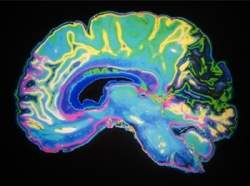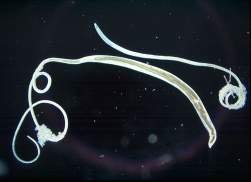Evolução da vacina
Uma nova vacina foi capaz de proteger uma espécie de macaco contra o equivalente em símios ao vírus HIV, apontando um novo caminho na busca por uma vacina para a proteção de humanos, segundo um estudo.
Pesquisadores norte-americanos dizem que a vacina protegeu 13 entre 24 macacos rhesus (primatas da famíliaCercopithecidae que habitam as florestas temperadas da Índia, China e Afeganistão) durante um experimento, eliminando o vírus da imunodeficiência símia (SIV na sigla em inglês), que equivale para os símios ao HIV.
Macacos não vacinados infectados com o SIV desenvolveram o equivalente a aids, causando o colapso de seus sistemas imunológicos.
Segundo os cientistas envolvidos, o estudo, publicado na revista Nature, pode "contribuir significativamente" para o desenvolvimento de uma vacina contra o HIV e a Aids.
Vacina contra HIV
A nova vacina é carregada por um vírus majoritariamente benigno que permanece no organismo a vida toda, o citomegalovírus (CMV).
O CMV é parte da família dos herpesvírus, família de vírus que inclui os vírus da catapora, do herpes simples e genital e do herpes zoster.
Por outro lado, o CMV manteria o sistema imunológico permanentemente em estado de alerta contra o HIV.
A vacina estimulou a produção de um tipo de célula sanguínea de defesa chamada Linfócito T Memória. Ela permanece vigilante no corpo muito tempo após o início de uma infecção, oferecendo proteção a longo prazo.
O líder da equipe de pesquisadores, Louis J. Picker, do Vaccine and Gene Therapy Institute, no Estado de Oregon, Estados Unidos, disse que as células T Memória são como soldados em prontidão.
Picker disse também que há evidências de que a vacina na verdade erradicou traços do SIV nos macacos, algo que, segundo ele, "é sem precedentes" em pesquisas sobre vacinas contra o HIV.
No experimento, 24 macacos saudáveis receberam uma vacina contendo uma versão geneticamente modificada do rhesus citomegalovírus (CMV).
Ele ofereceu proteção completa contra o SIV em 13 dos animais. Destes, 12 continuaram protegidos um ano mais tarde.
Problemas de segurança
Outros pesquisadores atuando nesta área receberam bem o novo estudo, mas ressaltaram problemas de segurança que teriam de ser resolvidos antes que um experimento desse tipo pudesse ser feito em humanos.
"Estou entusiasmado com o trabalho porque ele realmente demonstra que pode ser possível erradicar o vírus HIV a partir de uma resposta imunológica forte", disse o especialista Andrew McMichael, da Oxford University, na Inglaterra.
"Mas ao mesmo tempo estou me perguntando como seria possível adotar essa abordagem em humanos," diz
O problema seria a segurança em potencial e questões regulamentares associadas com a introdução do CMV em humanos - ainda que a maioria da população já seja portadora do vírus.
"O CMV não é totalmente benigno, ele causa uma série de doenças", disse McMichael. "Se você está introduzindo nas pessoas algo (o vírus) que não será capaz de eliminar, a possibilidade de ele trazer problemas é um risco muito difícil de administrar".
Vírus contra vírus
O cientista Robin Shattock, do Imperial College, em Londres, concordou que a segurança seria essencial.
"O avanço aqui foi usar uma vacina que é administrada por um vírus que permanece ativo, um vírus programado para destruir um vírus patogênico", disse Shattock. "O difícil vai ser mostrar que ele é seguro e efetivo em humanos".
Picker respondeu que essas questões vão ser abordadas em estudos futuros. Ele lembrou que as primeiras versões da vacina contra varíola também traziam riscos a humanos.
"Na África subsaariana, 99% das pessoas são CMV positivas e a metade da população no mundo desenvolvido também é", disse Picker. "Então sabemos bastante a respeito e (o vírus) é em grande parte não patogênico, exceto em populações vulneráveis, como mulheres grávidas".
Picker disse que o próximo passo é criar um vírus que tem uma habilidade maior de gerar células T memória mas não tem a capacidade de infectar porções vulneráveis da população.
Vacinas contra HIV
Para cientistas, desenvolver uma vacina contra o HIV tem se revelado um grande desafio, mas houve alguns resultados promissores.
Em 2009, pesquisadores na Tailândia publicaram na revista Lancet resultados obtidos com uma vacina experimental contra o HIV que, segundo os cientistas, reduziu o risco de contrair o vírus em um terço.
No ano passado, um estudo trazido pelo New England Journal of Medicine sugeriu que uma droga usada para tratar pacientes portadores do vírus HIV pode oferecer a homossexuais e bissexuais alguma proteção contra o vírus.
Testes feitos com a droga Truvada entre quase 2,5 mil homens sugerem que o medicamento pode reduzir as chances de contágio de homem para homem em 44%.
Um avanço definitivo, no entanto, ainda não ocorreu.






